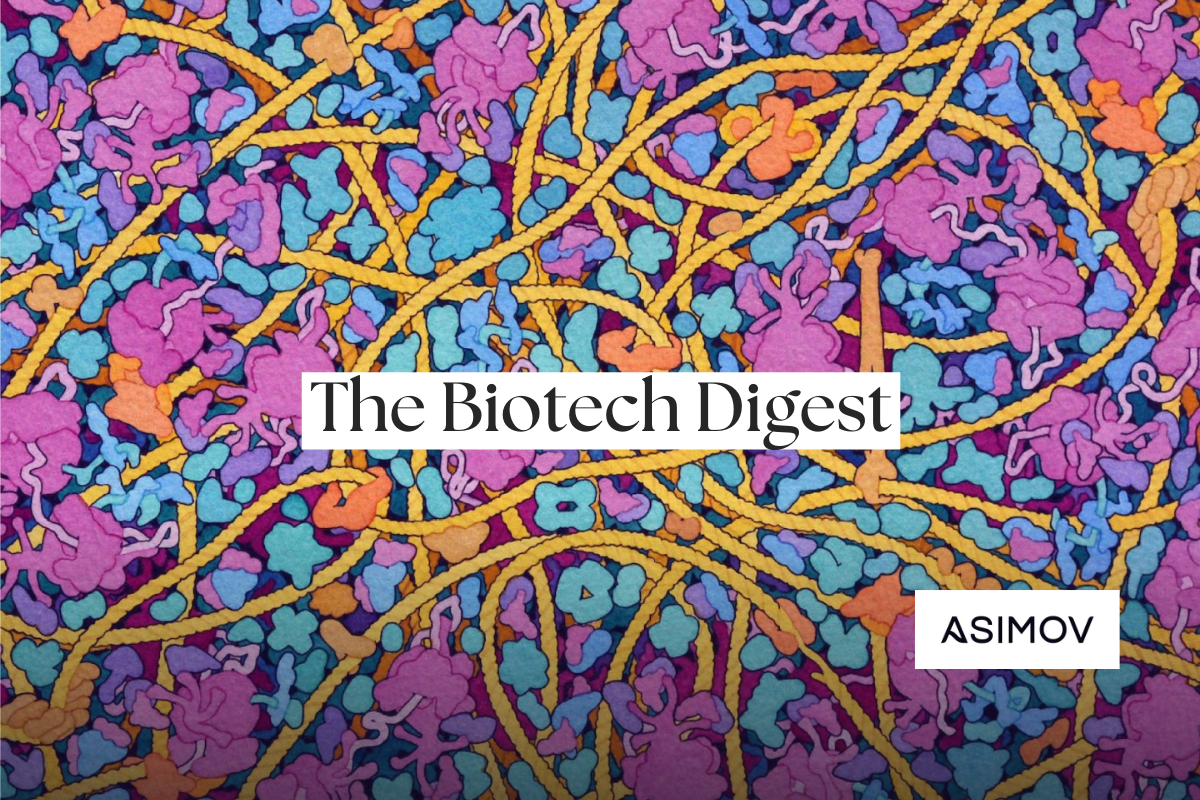The Biotech Digest No. 3
This weekly digest highlights recent papers and news in biotechnology. Please send feedback to niko@asimov.com.
Silencing Prions
There’s a new paper out of the MIT-Harvard-Broad Institute triumvirate. It describes an epigenetic editor, with a compact size, that can be used to silence genes across the brain—in this case, a prion that causes a devastating neurological condition. It’s only been tested on mice, but this tool has far-ranging potential for many other diseases, too.
The basic gist of epigenetics is that there are little chemical tags added to the genome that can change how DNA gets read. Adding a methyl group (CH3) to DNA often silences a gene's expression, for example. Adding phosphates or acetyl groups to histones, the big proteins that wrap up DNA, can activate or block a gene's expression. Epigenetic editors, then, are a programmable way (much like CRISPR-Cas9) to add or remove these marks, and thus change how the genome behaves.
For this study, the researchers developed an epigenetic editor, called CHARM (Coupled Histone tail for Autoinhibition Release of Methyltransferase), that can add methyl groups to specific locations in the genome. The scientists used it to shut down the expression of a prion protein throughout the brain of a mouse. Prions are misfolded proteins that can cause other healthy proteins to misfold. People who inherit a prion disease tend to exhibit neurodegenerative symptoms later in life, and one of the scientists who worked on this paper has a prion condition.
The great thing about CHARM, though, is that it can be used to silence lots of genes in the brain; not just prions. It's also small, easily fitting inside of the AAVs that are often used to make gene therapies. And because it doesn't alter DNA sequences directly, it's likely a safer option than base editors or prime editors to treat genetic diseases in many cases.
Duplicating Chromosomes
There’s a new genome-editing tool that flew under the radar this week. The Bridge RNA gene-editing papers from the Arc Institute rightly got a lot of coverage in the press (and I’ve provided links to all three of those papers below), but this other paper in Cell didn’t get quite so much attention.
Chinese scientists at Wuhan University and ShanghaiTech have invented a method, called amplification editing, that can duplicate anywhere from 20 bases to 100 million bases of DNA from a genome. The tool is programmable and can also be used to duplicate a sequence more than once. When it was used to duplicate one million bases, it did so with 73% efficiency.
Amplification editing works by fusing a Cas9 nickase to a reverse transcriptase fusion, similar to prime editors. A pair of pegRNAs guides the amplification. Here’s more from the paper (which is unfortunately paywalled):
“To duplicate a sequence of interest, a Cas9 nickase-reverse transcriptase fusion (PE2) and a pair of pegRNAs with proto- spacer-adjacent motif (PAM)-out orientation are designed. The sequence of interest is nicked by the Cas9 nickase at both ends, and the RTTs of the pegRNAs are designed to generate two complementary 30 flaps (Figure 1A). These flaps anneal and prime DNA synthesis using one strand of the sequence be- tween the two nicks as a template. The sequence of interest is precisely duplicated with a small inserted sequence in between, which is generated by the 30 flaps.”
The tool was tested in many different cells and at many sites in the genome. “Efficiencies ranged from 56.3% to 68.5% for 200 bp duplications, 28.5%–47.8% for 1–2 kb, and 20.4%–33.3% for 7–9 kb,” according to the study.
Amplification editing seems to work best in mouse cells, and not as good in certain human cell lines. In primary human T-cells, for example, its efficiency ranged from 0.57% to 28.6%. The tool’s efficiency when duplicating 100 million bases of DNA (the size of some entire chromosomes) was about 1% in HEK293T cells.
The applications of this tool will be far-reaching. Initially, it could be used to make mouse models and human cell lines with chromosome duplications to study genetic disorders. And as with any genome-editing tool, I’m sure it will get better in time.
Yeast Paintings
Science museums are filled with exhibits about space, rockets, big machines, and so on. But biology—if it’s mentioned at all—is often relegated to dusty corners, with little more than old vials or microscopes on display. If biology is actually as important as we all think it is, then we need to do a better job at getting kids excited about this field.
Although this is a bit different from the other things I normally write about in this newsletter, I really enjoyed reading this brief article about the “yeast paintings” that scientists in Jef Boeke’s laboratory at New York University are making. Boeke is famous, in part, for leading the international Sc2.0 effort, which aims to make a yeast cell with a fully synthetic (that is, chemically-synthesized) genome. But he also leads a Yeast Art Project.
First, students engineer yeast to produce different colors; pigments, carotenes, and so on. Yellows, oranges and reds tend to dominate. But there are also some rich tan colors, bright blues, and pinks in these paintings. Each yeast is gently dabbed onto an agar canvas using a robot. Once the cells grow, they fill their pixel on the canvas and a painting emerges. The full art collection is available online. It makes for enjoyable scrolling.




Papers You Might Have Missed
Gene-Editing Papers
- *Bridge RNAs direct programmable recombination of target and donor DNA. Nature
- *Structural mechanism of bridge RNA-guided recombination. Nature
See news coverage in Ars Technica and Nature - A programmable seekRNA guides target selection by IS1111 and IS110 type insertion sequences. Nature Communications
- *Transposase-assisted target-site integration for efficient plant genome engineering. Nature
- Machine learning prediction of prime editing efficiency across diverse chromatin contexts. Nature Biotechnology
More Papers
TnpB homologues exapted from transposons are RNA-guided transcription factors. Nature
*GLP-1 increases preingestive satiation via hypothalamic circuits in mice and humans. Science
Open-ST: High-resolution spatial transcriptomics in 3D. Cell
Engineered yeast multicellularity via synthetic cell-cell adhesion and direct-contact signalling. bioRxiv
Extended supercooled storage of red blood cells. Communications Biology
A multi-kingdom collection of 33,804 reference genomes for the human vaginal microbiome. Nature Microbiology
Synthetic gene circuit evolution: Insights and opportunities at the mid-scale. Cell Chemical Biology
Data hazards in synthetic biology. Synthetic Biology
Tunable translation-level CRISPR interference by dCas13 and engineered gRNA in bacteria. Nature Communications
Spatial mapping of mobile genetic elements and their bacterial hosts in complex microbiomes. Nature Microbiology
Divergent landscapes of A-to-I editing in postmortem and living human brain. Nature Communications
Phage predation accelerates the spread of plasmid-encoded antibiotic resistance. Nature Communications
A treasure trove of 1034 actinomycete genomes. Nucleic Acids Research
Optimizing 5’UTRs for mRNA-delivered gene editing using deep learning. Nature Communications
Designing cell-type-specific promoter sequences using conservative model-based optimization. bioRxiv
ATP biosensor reveals microbial energetic dynamics and facilitates bioproduction. Nature Communications
Eliminating malaria vectors with precision-guided sterile males. PNAS
An all-atom protein generative model. PNAS
Beta-lactamase dependent and independent evolutionary paths to high-level ampicillin resistance. Nature Communications
Tuning the performance of a TphR-based terephthalate biosensor with a design of experiments approach. bioRxiv
Development of a genetically encoded sensor for probing endogenous nociceptin opioid peptide release. Nature Communications
Resistance to freezing conditions of endemic Antarctic polychaetes is enhanced by cryoprotective proteins produced by their microbiome. Science Advances
The maintenance of oocytes in the mammalian ovary involves extreme protein longevity. Nature Cell Biology
Fluorgenic probes of the Mycobacterial membrane as reporters of antibiotic action. JACS
CapTrap-seq: a platform-agnostic and quantitative approach for high-fidelity full-length RNA sequencing. Nature Communications
Phenotyping floral attractiveness to pollinators using volatilomics, 3D-imaging and insect monitoring. Molecular Plant
Deconstructing synthetic biology across scales: a conceptual approach for training synthetic biologists. Nature Communications
Combining an artificial metathase with a fatty acid decarboxylase in a whole cell for cycloalkene synthesis. Nature Synthesis
A new landscape for malaria vaccine development. PLOS Pathogens
Microbiome manipulation by corals and other Cnidaria via quorum quenching. Current Biology
Model-guided design of microRNA-based gene circuits supports precise dosage of transgenic cargoes into diverse primary cells. bioRxiv
A biosensor-based phage display selection method for automated, high-throughput Nanobody discovery. bioRxiv
A cell-free transcription-translation pipeline for recreating methylation patterns boosts DNA transformation in bacteria. Molecular Cell
In Other News…
*First synthetic gene drive for plants could help eradicate weeds. Science
*Detecting genetically engineered viruses with metagenomic sequencing. Nucleic Acid Observatory
How blockbuster obesity drugs create a full feeling — even before one bite of food. Nature
AAV vectors for long-term gene therapy of hemophilia B: Are we there yet? Molecular Therapy
How AI Revolutionized Protein Science, but Didn’t End It. Quanta Magazine
Uncovering Secrets of Historic Paintings in the Modern Laboratory. The Scientist
With AI Tools, Scientists Can Crack the Code of Life. WIRED
Insecticides made of RNA could offer a safer and more targeted weapon against crop pests. Science
Top FDA official overrules staff to approve gene therapy that failed trial. Ars Technica
Vutrisiran, a drug from Alnylam for a heart condition called ATTR-CM, “cut the risk of death and recurrent cardiovascular complications by 28% vs. placebo.” STAT
EvolutionaryScale raises $142M for protein-generating AI. Tech Crunch
Landmark gene-edited rice crop destroyed in Italy. (First field trial in the country for a gene-edited crop.) Science
Nature staff have been striking over pay. Science
Fractyl Health, a startup company, wants to insert the transgene that encodes GLP-1 drugs into beta islet cells to make the weight-loss therapies permanent. Fierce Biotech


